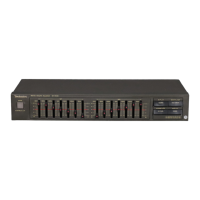Examples of Applications
By using the seven frequency divisions in the 63 Hz-16 kHz frequency range of the equalization function, various corrections of the sound field
and tone quality are possible.
For creation of a sound field in the listening
room.
• Correcting room acoustics
Each room has its own particular effects on frequency
characteritics. These effects are determined by a number
of conditions, such as room size, furnishings, etc.
The 7 separate divisions of the band level control on the
this unit make it possible to selectively correct only the
frequency ranges necessary to suit the conditions of each
listening room.
An example of room acoustics correction
In order to correct the peaks and dips in bass sounds
caused by reflection reduce, the 160 Hz level 4-6 dB and
then, raise the level of sounds below the 63 Hz and above
the 6.3 kHz vicinity slightly.
f
For editing "live" recordings made on tape,
etc.
• Cutting the noise from live recording tapes
Live tapes recorded outdoors generally contain popping
noises caused by wind and various other noises from the
surrounding area. In order to effectively eliminate wind
noise, cut bass sounds below 63 Hz and raise the level of
sounds in the 400 Hz range. Then control sounds made by
birds, etc., with a 6.3 kHz adjustment.
• Making tapes for car stereos
Tapes can be made exclusively for the listening conditions
inside a vehicle. Merely raise the 63 Hz level 3-4 dB.
For medium and low frequencies, centering on the 400 Hz
vicinity, lower the modulating effect by raising the 2.5
kHz_6.3 kHz vicinity by 2_4 dB.
For creation of unique, individually
personalized sounds.
• Producing clear vocals
For female vocals, raise the level of the 1 kHz-2.5 kHz
range by 2_4 dB. To rectify omission, raise the level of
the 6.3 kHz vicinity slightly.
Male vocals can be improved by raising the level of the
400 Hz--2.5 kHz range.
Below Is an example of a female vocal correction,
• Adding some power to disco music
Increase the power of bass guitars and bass drums by
raising the level of the 63 Hz_ 160 Hz range, and raise the
level of sounds from 6.3 kHz to 16 kHz. The result will be
greatly emphasized low frequency sounds and strong,
clear high frequency sounds.
J
For noise reduction and "howling"
prevention.
• Cutting noise from discs
Noises from warped discs are low frequency noise
components. Lowering the sound level of the 63 Hz
vicinity can eliminate these.
As for cutting the noise from old discs, all band level
control levers should first be set to their exact mid-position
(flattening the equalizer effect) and then lowered one by
one to the "-12 dB" position, listening to the effect of
each adjustment.
The noise components can thus be found and cut without
deteriorating the sound quality.
• Reducing tape hiss
Tape hiss can be effectively reduced by slightly raising the
level of high frequency (above 2.5 kHz) sounds during
tape deck recording, and then lowering them during
playback.
Note:
If sounds above 6.3 kHz are raised too much, distortion
may result in the tape deck. Prevent this by watching the
level meters of the tape deck and setting the recording
levels appropriately.

